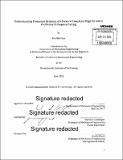Understanding frequency response of a flexural complaint stage for use in oscillatory orthogonal cutting
Author(s)
Barraza, Raul
DownloadFull printable version (6.211Mb)
Other Contributors
Massachusetts Institute of Technology. Department of Mechanical Engineering.
Advisor
Martin L. Culpepper.
Terms of use
Metadata
Show full item recordAbstract
Ultramicrotomy is the process of cutting specimens into submicron-thickness slices for subsequent imaging using a scanning electron microscope (SEM). Ultramicrotomes, devices that employ this process, have incorporated oscillations into this process to reduce the damage done on each slice. Extensive research has been made in trying to identify the appropriate settings: frequency, amplitude of cut, and feed speed, to maximize the reduction of this damage. Currently, however, there exists no research that tries to understand why the introduction of oscillations provides such a reduction in damage. To understand the mechanics behind oscillatory orthogonal cutting, specifically in ultramicrotomy, the frequency response of a compliant mechanism must be understood. The frequency response of a complaint flexural stage driven by piezoelectric actuator was measured. Using a Linear Variable Differential Transformer (LVDT) and a dynamic signal analyzer via LabView, the frequency response of the stage was measured from 100Hz to 10000Hz. A model was then fitted to the measured response. Using this model, a comparison between a simulated-reference response of the position of the stage to the output response of the model showed that a controller was required to minimize the error in the position of the stage.
Description
Thesis: S.B., Massachusetts Institute of Technology, Department of Mechanical Engineering, 2015. Cataloged from PDF version of thesis. Includes bibliographical references (page 49).
Date issued
2015Department
Massachusetts Institute of Technology. Department of Mechanical EngineeringPublisher
Massachusetts Institute of Technology
Keywords
Mechanical Engineering.